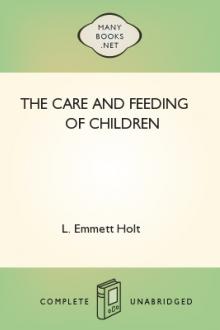The Care and Feeding of Children, L. Emmett Holt [phonics books .txt] 📗

- Author: L. Emmett Holt
- Performer: -
Book online «The Care and Feeding of Children, L. Emmett Holt [phonics books .txt] 📗». Author L. Emmett Holt
Give a proper diet for an average child from the fourteenth to the eighteenth month.
The bottle should not be given except at night. Cereals may now form an important part of the diet. They should be very thoroughly cooked, usually for three hours, and strained.
The daily schedule should be about as follows:
Give a proper diet for an average child from the eighteenth month to the end of the second year.
The same order of meals as for the months just preceding should be followed. For most children milk at 10 P.M. is desirable. There are many, however who sleep regularly from 6 P.M. until 6 A.M. without food; for such the night feeding should, of course, not be insisted upon.
The daily schedule should be about as follows:
What fruits may be given at this period?
If the child has a feeble digestion, only the fruit juices previously allowed; strong children may have in addition prune pulp, baked apple, and applesauce. The prune pulp is prepared by stewing the dried prunes without sugar until they are very soft, and removing all the skin by putting the fruit through a strainer; of this from one to two tablespoonfuls may be given at one time. The baked apple should be given without cream, and the applesauce should have very little sugar.
How and when should water be given?
Throughout the second year water should be given freely between the feedings, especially in warm weather; from one to three ounces may be given at one time, either from a spoon, a glass, or a bottle. The water should be boiled daily and then cooled. It should not be allowed to stand in the room, but fresh water should be put into the bottle each time.
FEEDING DURING THE THIRD YEAR
What changes may be made in the diet during the third year?
The night feeding at 10 P.M. should be omitted. A greater quantity of solid food may be allowed, particularly at the mid-day meal. It is not advisable to begin potato and other vegetables until this age is reached. Three regular meals should be given and milk once besides, either between the breakfast and dinner or dinner and supper, whichever is the longer interval. Water should be allowed freely between meals.
What would be a proper schedule for an average child during the third year?
PART III
THE DIET OF OLDER CHILDREN (FOURTH TO TENTH YEAR)
Throughout this period the largest meal should always be in the middle of the day, and a light supper given, very much like that described for the third year. During the first half of this period, milk may be allowed once either between breakfast and dinner or dinner and supper; no other eating between meals should be permitted, but water should be allowed freely.
MILK AND CREAM
What part of the diet should milk form during childhood?
It should form a very important part up to the tenth year; nothing can take its place. There are comparatively few children who cannot take and digest milk if it is properly fed.
Why is milk so advantageous?
Because no food that we possess has so high a nutritive value as milk, for the amount of work required of the organs of digestion. It is, therefore, peculiarly adapted to the diet of the child.
What are the essential points in the use of milk?
It should be clean and fresh, but not too rich. It is a mistake to select for any children the rich milk of a Jersey herd and use it as though it were an ordinary milk. For children who have difficulty in digesting milk, it should be somewhat diluted, i.e., one part of water to four parts of milk, or salt or bicarbonate of soda should be added. It is also important not to give milk at meals when fruits, especially sour fruits, are allowed.
How much milk may advantageously be given?
The average child with good digestion should take from one and one half pints to one quart of milk daily, this including not only what the child drinks but what is served upon cereals and in other ways. It is seldom wise to allow a child to take as much as two quarts daily, as a more mixed diet for most children is better.
To what extent may cream be used?
Older children do not require so large a proportion of fat in their food as do infants, and the use of cream, especially very rich cream, often results in disturbances of digestion. The use of too much or too rich cream is a common cause of the coated tongue, foul breath and pale gray stools, often called "biliousness."
Is not cream useful in overcoming the constipation of children?
With infants it is valuable to a certain point, but with older children only to a limited degree, and if such symptoms as those above described are present, cream should not be given.
EGGS
To what extent may eggs be used in the diet of this period?
They form a most valuable food. It is essential that they should be fresh and only slightly cooked, soft boiled, poached or coddled; fried eggs should never be given and all omelets are objectionable.
Which is more digestible, the white or yolk of the egg?
For the great majority of children, the white of the egg. This forms one of the most digestible proteids we possess, and can be used, even in the latter part of the first year, with advantage.
Is it not true that eggs often cause "biliousness"?
Very seldom, if fed as above advised. This is an old prejudice but has little basis in fact.
How often may eggs be given?
Most children from four to ten years old will take one egg for breakfast and another for supper for an indefinite period with relish and benefit. There are, however, some few who have a peculiar idiosyncrasy as regards eggs and cannot take them at all.
MEAT AND FISH
What meats may be given to young children?
The best are beefsteak, mutton-chop, roast beef, roast lamb, broiled chicken and certain delicate fish, such as shad or bass.
What are the important points to be considered in giving meat to children?
Most meats should be rare and either scraped or very finely divided, as no child can be trusted to chew meat properly. Meats are best broiled or roasted, but should not be fried.
How often should meat be given?
At this period, only once a day, at the mid-day meal.
Is not the excessive nervousness of many modern children due to the giving of meat, or at least aggravated by its use?
There is little ground for such a belief, unless an excessive amount of meat is given. Certainly cutting off meat from the diet of nervous children seldom produces any striking benefit.
What meats should be forbidden to young children?
Ham, bacon, sausage, pork, liver, kidney, game and all dried and salted meats, also cod, mackerel and halibut; all of these are best withheld until the child has passed the tenth year.
Are not gravies beneficial and nutritious?
The beef juice, or so-called "platter gravy," from a roast is exceedingly nutritious and desirable, but many of the thickened gravies are much less digestible and are too often given in excess; only a small quantity should be allowed. They should not form an important part of the meal.
VEGETABLES
What vegetables may be used at this period?
White potatoes may be given first. These should preferably be baked or boiled and mashed, but never fried. They should be served with beef juice or with cream rather than with butter.
Of the green vegetables, the best are peas, spinach, asparagus tips, string beans, stewed celery, young beets, or carrots, and squash. Baked sweet potato, turnips, boiled onions and cauliflower, all well cooked, may be given after the sixth or seventh year in moderate amount.
The principal trouble in the digestion of vegetables is due to imperfect cooking. It is, in fact, almost impossible to cook them too much; they should also be very finely mashed. They form a valuable addition to the diet after three years, although the amount at first given should be small, one or two teaspoonfuls. They greatly aid in securing regularity of the bowels. Because small particles are seen in the stools, it is not to be inferred that they are causing disturbance





Comments (0)